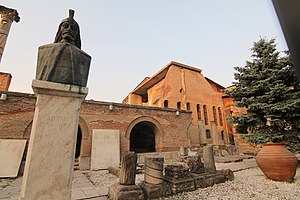Curtea Veche

Curtea Veche(theOld Princely Court) was built as a palace or residence during the rule ofVlad III Draculain 1459.[1]Archaeological excavations started in 1953, and now the site is operated by theMuzeul Municipiului Bucureștiin the historic centre ofBucharest,Romania.
Voivode’s Palace
[edit]Vlad the Impaler's reign was dominated by conflicts with theOttoman Empire,hence the necessity to permanently watch over and protect the southern border, theDanube,made him stay in the fortified town on theDâmbovițabanks. He issued a Latin document on 13 June 1458 from the area of current Bucharest. Then, on 20 September 1459, he issued a document in Slavonic, specifically referring to the "fortress" in Bucharest, his "princely residence". Other documents were issued in 1460 and 1461. Vlad would have been accompanied by his family, courtiers, and an army corps.[2]: 23
During his reign,Mircea Ciobanulrepaired the palace, and defined the limits of the city.[2]: 25 His palace became the economic nucleus of Bucharest, surrounded by the houses of traders and craftsmen known as theLipscani.Matei Basarabrepaired the palace during his own reign, so that it was "completely rebuilt...amazingly elegant" with a "charming aspect, much finer and gayer".[2]: 30–31 Constantin Brâncoveanurebuilt and extended the palace using stone, including a great marble staircase at the entrance.[2]: 36
Alexander Ypsilantisbuilt anew princely courtin 1775 atDealul Spirii.The old court was auctioned in 1798 byConstantine Hangerli.
-
Vlad Țepeș document establishing his court here on 20 September 1459[3]
-
Palatul Voievodal interior
-
Palatul Voievodal oven
Annunciation Church of Saint Anthony
[edit]
This princely church was built by Mircea Ciobanul in 1559, and is the location of his grave. The church is "the oldest religious building maintained in its original aspect in Bucharest".[2]: 25
-
Biserica Sfântul Anton altar
-
Biserica Sfântul Anton dome
-
Biserica Sfântul Anton marker
Popular culture
[edit]In its current role as a museum, the palace and neighbourhood inspiredMateiu Caragialeto write his novelCraii de Curtea-Veche.It is also at the center of efforts to restore the historic center of Bucharest.[4]
See also
[edit]References
[edit]- ^John Moore (2007-07-28)."Lifting the Iron Curtain".Toronto Star.Retrieved2008-03-27.
- ^abcdeGiurescu, Constantin C.(1976).History of Bucharest.Bucharest: The Publishing House for Sports and Tourism.
- ^Conserved at theNational Museum of Romanian History
- ^Pocotila, Andreea (2006-07-21)."'A Beautiful Bucharest' - the Next Step in Restoring Historical Heart ".Bucharest Daily News.Archived fromthe originalon 2011-05-17.Retrieved2008-03-27.
External links
[edit]- "Muzeul Curtea Veche".ICI.ro(in Romanian). Archived from the original on 2013-01-13.Retrieved2019-02-15.
{{cite web}}:CS1 maint: bot: original URL status unknown (link)

![Vlad Țepeș document establishing his court here on 20 September 1459[3]](https://upload.wikimedia.org/wikipedia/commons/thumb/1/1f/Vlad_Tepes_document.jpg/67px-Vlad_Tepes_document.jpg)





